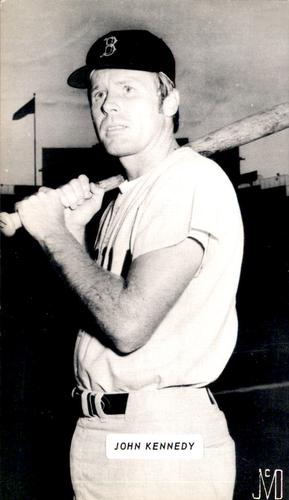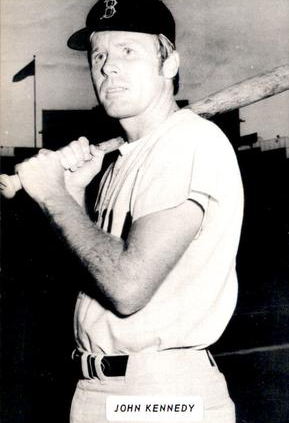July 5, 1970: John Kennedy hits inside-the-park home run in his first plate appearance for Red Sox
 Utility infielder John Kennedy joined the Boston Red Sox on June 26, 1970, purchased from the Milwaukee Brewers and arriving from the Triple-A Portland Beavers.1
Utility infielder John Kennedy joined the Boston Red Sox on June 26, 1970, purchased from the Milwaukee Brewers and arriving from the Triple-A Portland Beavers.1
Kennedy had broken into the big leagues with the Washington Senators on September 5, 1962, and he broke in with a bang. In his first big-league at-bat, Kennedy – pinch-hitting for the Senators’ pitcher in the sixth inning – homered off Dick Stigman of the Minnesota Twins, giving Washington its first hit of that game. The Senators ultimately lost in 11 innings, 9-7.
The Red Sox were Kennedy’s fifth major-league team, including a World Series championship with the 1965 Los Angeles Dodgers and a National League pennant with the ’66 Dodgers.2 He had picked up the nickname Super-Sub, acknowledging his versatility in the infield. As SABR biographer Paul Hirsch wrote, “From his arrival in Boston on June 26, 1970, until his release in October 1974, Kennedy enjoyed his longest continuous stretch with one club. He hit better, played more games, and played all over the infield (plus designated hitter) during his Red Sox years. The two World Series appearances with the Dodgers were special, but Kennedy said he made his reputation in baseball during his time with the Red Sox and was able to set himself up for a career in the game after he was done playing.”3
Though Kennedy joined the ’70 Red Sox on June 26, eight days elapsed before he got into a game.
It was a Sunday afternoon at Fenway Park. The day before – the Fourth of July – the Red Sox had exploded for home runs by Mike Andrews, Reggie Smith, and Tony Conigliaro in the bottom of the seventh and beaten the visiting Cleveland Indians, 5-1.
Boston was in fourth place in the six-team American League East Division, eight games behind the first-place Baltimore Orioles. The Red Sox had won five games in a row, including a doubleheader sweep from the Indians on July 3.
First-year Red Sox manager Eddie Kasko gave the start to 22-year-old right-hander Mike Nagy (2-1, 4.78), who had won on July 1, 6-5, over the Senators. This Sunday game drew 21,690.
Al Dark was the Indians’ manager. His starter was 23-year-old rookie left-hander Rick Austin. It was Austin’s fourth career start, after he made his major-league debut on June 21. His second start had been a 3-0 shutout of the Detroit Tigers on June 27. On July 1, Baltimore had shut out the Indians, 3-0, Austin taking the loss.
Nagy walked two in the top of the first but suffered no damage. Austin retired the Red Sox in order in the bottom of the inning.
The Indians scored once in the top of the second. After one out, first baseman Tony Horton, who had hit for the cycle three days earlier against the Orioles, singled to left. Second baseman Eddie Leon singled to right field. With Austin batting, Nagy uncorked a wild pitch; Horton scored and Leon took second. Austin then doubled to left-center, but an 8-4-2 relay from center fielder Smith to second baseman Andrews to catcher Jerry Moses got Leon out at home plate.
Cleveland added a second run in the top of the third inning when third baseman Graig Nettles led off with a home run into the visitors bullpen in right field.
In the bottom of the fourth, the Red Sox tied the score, 2-2. Smith walked. Don Pavletich took a called third strike.4 Tony Conigliaro singled to center, Smith going first to third. Rico Petrocelli singled, Smith scoring with Conigliaro stopping at second. George Scott then singled to right field, driving in Conigliaro, while Petrocelli went to third base.
The Red Sox had a chance to go ahead, but Nettles fielded a grounder hit by left fielder Billy Conigliaro – who had joined his older brother Tony on the Red Sox roster a season earlier – and threw to the plate, where Ray Fosse tagged out Petrocelli. Moses hit into an inning-ending force play at second base.
After two outs in the top of the fifth, three consecutive singles off Nagy allowed the Indians to retake the lead, 3-2. All three were hit to center field, by Vada Pinson, Fosse, and an RBI single by left fielder Duke Sims. Nagy got rookie right fielder Roy Foster to ground into a force play at second base to end the inning.
With Nagy due to lead off the bottom of the inning, Kasko decided to pinch-hit for him. John Kennedy stepped into the right-handed batter’s box for his first appearance in a Red Sox game. Manager Dark motioned to Foster to not play as deeply in right.
Kennedy hit a “twisting fly” to Foster’s left.5 As the Boston Globe reported, “The ball sailed away some from Foster, who made a desperate leap for it … and missed. As Foster lay on the ground, Kennedy gathered up steam and headed around the bases. The ball was chased to the Cleveland bullpen. Kennedy beat the relay and the Red Sox were tied, 3-3.”6
It “should have been no more than a double at most,” declared the Cleveland Plain Dealer. “It was a liner to right that sliced away from Roy Foster at the last moment, and when the outfielder left his feet, the ball rolled into the distant corner. Kennedy made it easily.”7
Perhaps not all that easily. After the game, Kennedy said, “I nearly died rounding third base, Pop [third-base coach Eddie Popowski] hollered to me that I’d make it if I didn’t fall down.”8
Kennedy’s homer tied the score and started the rally that put the Red Sox ahead to stay. After Smith doubled off the wall in left-center, Dark called on Phil Hennigan in relief. Mike Fiore flied out to shortstop,9 but Tony Conigliaro doubled to left-center, driving in Smith. Petrocelli followed with his own double to left-center, driving in Conigliaro. It was 5-3, Red Sox.
Former Indian Vicente Romo took over in relief for Boston in the sixth.10 A solo home run to left by Rich Rollins, batting for Hennigan, got one run back for the Indians.
The Red Sox responded with two insurance runs against reliever Dennis Higgins in the bottom of the sixth. Billy Conigliaro led off with a double to left. Moses singled and Conigliaro scored. Romo – batting for himself – laid down a sacrifice bunt, allowing Moses to take second base. Andrews singled, scoring Moses. Boston now held a 7-4 lead. Dick Ellsworth, who had gone to Cleveland in the April 1969 deal that sent Romo to the Red Sox, relieved Higgins and got the two outs needed to end the inning.
Romo pitched the rest of the game for the Red Sox, four innings of relief. He allowed a one-out single to Pinson in the top of the seventh and a two-out single by Nettles in the top of the ninth. He then secured the third and final out.
In the Red Sox seventh, Ellsworth – who likewise worked the rest of the game – allowed back-to-back singles by Petrocelli and Scott. Billy Conigliaro hit into a force play at second base, Petrocelli having to hold at third base. But when Moses followed with a grounder to short, Petrocelli scored to increase the Red Sox lead to 8-4.
That was the final score. The Red Sox had their sixth win in a row.
Kennedy got his first start on July 12, playing second base in the second game of a doubleheader in Cleveland. He played in both games of a July 22 doubleheader and then worked almost every game into early September but was again relegated to backup roles, getting only 11 plate appearances in September. He finished the year batting .255, adding three more home runs.
Kennedy had 19 career home runs before joining the Red Sox; he hit 13 in his time with Boston. His home run in his Boston debut was the only inside-the-parker of his 12-season major-league career.
Acknowledgments
This article was fact-checked by Victoria Monte and copy-edited by Len Levin.
Sources
In addition to the sources cited in the Notes, the author consulted Baseball-Reference.com and Retrosheet.org.
https://www.baseball-reference.com/boxes/BOS/BOS197007050.shtml
https://www.retrosheet.org/boxesetc/1970/B07050BOS1970.htm
Notes
1 The Boston Globe dubbed it a “minor deal” and said, “Kennedy, a veteran glove man, with seven years’ service, is more a gloveman than anything else.” Will McDonough, “Lonborg, Better, May Pitch Soon,” Boston Globe, June 27, 1970: 18.
2 Kennedy was a member of both the 1969 Seattle Pilots and then, when that franchise moved to Milwaukee, the 1970 Brewers, before his contract was sold to the Red Sox.
3 Paul Hirsch, “John Kennedy,” SABR BioProject. His post-playing career was as a manager and scout.
4 Pavletich had entered the game in the top of the third inning, replacing Carl Yastrzemski at first base. Yastrzemski was still bothered by a sore arm after being hit on the elbow by a pitch the day before.
5 Peter Gammons, “A Day for Kennedy; and Another Sox Win,” Boston Globe, July 6, 1970: 20.
6 Clif Keane, “Sox Sweep Indians, Win Sixth in Row, 8-4,” Boston Globe, July 6, 1970: 19.
7 Russell Schneider, “Bosox Rip Tribe, 8-4,” Cleveland Plain Dealer, July 6,1970: D1.
8 D. Leo Monahan, “Red Sox Win 6th in Row, 8-4,” Boston Record-American, July 6,1970: 34.
9 Fiore had replaced Pavletich at first base.
10 The Red Sox acquired Romo, Joe Azcue, and Sonny Siebert from the Indians for Ken Harrelson, Juan Pizarro, and Dick Ellsworth on April 19, 1969.
Additional Stats
Boston Red Sox 8
Cleveland Indians 4
Fenway Park
Boston, MA
Box Score + PBP:
Corrections? Additions?
If you can help us improve this game story, contact us.


